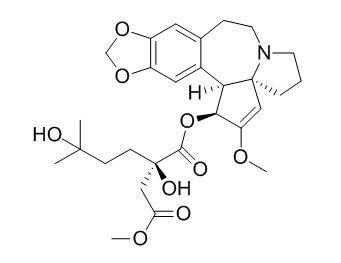Harringtonine
Harringtonine , an anticancer drug with high chemotherapeutic efficiency to human chronic granulocytic/myelomonocytic leukemia, has been reported to rapidly induce apoptosis in HL-60 cells in a wide scope/range of dosage by investigators from our lab and others. Harringtonine exerts its antiviral effects by inhibiting Chikungunya virus (CHIKV) viral protein synthesis.
Inquire / Order:
manager@chemfaces.com
Technical Inquiries:
service@chemfaces.com
Tel:
+86-27-84237783
Fax:
+86-27-84254680
Address:
1 Building, No. 83, CheCheng Rd., Wuhan Economic and Technological Development Zone, Wuhan, Hubei 430056, PRC
Providing storage is as stated on the product vial and the vial is kept tightly sealed, the product can be stored for up to
24 months(2-8C).
Wherever possible, you should prepare and use solutions on the same day. However, if you need to make up stock solutions in advance, we recommend that you store the solution as aliquots in tightly sealed vials at -20C. Generally, these will be useable for up to two weeks. Before use, and prior to opening the vial we recommend that you allow your product to equilibrate to room temperature for at least 1 hour.
Need more advice on solubility, usage and handling? Please email to: service@chemfaces.com
The packaging of the product may have turned upside down during transportation, resulting in the natural compounds adhering to the neck or cap of the vial. take the vial out of its packaging and gently shake to let the compounds fall to the bottom of the vial. for liquid products, centrifuge at 200-500 RPM to gather the liquid at the bottom of the vial. try to avoid loss or contamination during handling.
Pharmacol Rep.2022, 74(1):175-188.
J Cell Mol Med.2021, 25(5):2645-2654.
Kor. J. Herbol.2019, 34(2):59-66
Phytomedicine.2018, 41:62-66
Int J Biol Macromol.2018, 112:1093-1103
Int J Mol Sci.2024, 25(2):764.
Applied Biological Chem. 2020, 26(63).
The Korea Journal of Herbology2020, 35(3):33-45.
Food Res Int.2021, 148:110607.
Life (Basel).2023, 13(2):457.
Related and Featured Products
Cancer Lett. 1998 May 15;127(1-2):113-21.
Intracellular calcium distribution in apoptosis of HL-60 cells induced by harringtonine: intranuclear accumulation and regionalization.[Pubmed:
9619866]
Harringtonine (HT), an anticancer drug with high chemotherapeutic efficiency to human chronic granulocytic/myelomonocytic leukemia, has been reported to rapidly induce apoptosis in HL-60 cells in a wide scope/range of dosage by investigators from our lab and others.
METHODS AND RESULTS:
In the present studies, by using video enhancement contrast (VEC) microscopy, we dynamically analyzed changes in intracellular calcium distribution in a single HL-60 cell over the period from the initiation of apoptosis to the obvious appearance of chromatin condensation. The results from this paper demonstrated the striking distinction of intracellular calcium distribution at different time points after treatment with HT. Before treatment in normal HL-60 cells the highest [Ca2+]i accumulation was observed in the peri-nuclear area and the lowest was observed in the nucleus; after treatment with 1 microg/ml HT for 30 min intracellular calcium diffused all over the cell compartments, while intranuclear calcium increased comparatively and significantly. The phenomenon of intranuclear calcium accumulation was further confirmed by using laser scanning confocal microscopy (LSCM). In addition, co-localization of the highest calcium region with condensed chromatin in apoptotic HL-60 cells was also observed by LSCM.
CONCLUSIONS:
Our results suggest that two sequential alterations of intracellular calcium distribution occurred in apoptotic HL-60 cells induced by HT, i.e. (a) accumulation of calcium in the nucleus and (b) regionalization in a specific nuclear region.
Antimicrob. Agents Chemother., 2013, 57(1): 155-67.
Inhibition of Chikungunya Virus Replication by Harringtonine, a Novel Antiviral That Suppresses Viral Protein Expression[Reference:
WebLink]
Chikungunya virus (CHIKV) is a mosquito-transmitted virus that has reemerged as a significant public health threat in the last decade.
METHODS AND RESULTS:
Harringtonine, a cephalotaxine alkaloid, displayed potent inhibition of CHIKV infection (50% effective concentration [EC50] = 0.24 μM) with minimal cytotoxicity and was selected for elucidation of its antiviral mechanism. Time-of-addition studies, cotreatment assays, and direct transfection of viral genomic RNA indicated that Harringtonine inhibited an early stage of the CHIKV replication cycle which occurred after viral entry into cells. In addition, quantitative reverse transcription-PCR (qRT-PCR) and Western blot analyses indicated that Harringtonine affects CHIKV RNA production as well as viral protein expression.
CONCLUSIONS:
Treatment of Harringtonine against Sindbis virus, a related alphavirus, suggested that Harringtonine could inhibit other alphaviruses. This study suggests for the first time that Harringtonine exerts its antiviral effects by inhibiting CHIKV viral protein synthesis.



